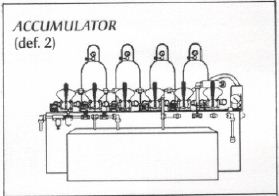نمایش نتیجه 21 تا 30 از 2718 نتیجه یافت شده برای v:
n: the maximum volume of natural gas that can be processed through an absorber at a specified absorption oil rate, temperature, and pressure without exceeding pressure drop or any oilier operating limitation.
n: the gasoline extracted from natural gas by putting the gas into contact with oil in a vessel and subsequently distilling the gasoline from the heavier oil.
gasoline extracted from wet natural gas by putting the gas in contact with oil.
n: a procedure whereby a product may be subjected to intensified but controlled conditions of heat, pressure, radiation, or other variables to produce, in a short time, the effects of long- time storage or use under normal conditions.
n: 1. a vessel or tank that receives and temporarily stores a liquid used in a continuous process in a gas plant. See drip accumulator. 2. on a drilling rig, the storage device for nitrogen-pressurised hydraulic fluid, which is used in operating the blow out preventers. See blowout preventer control unit.
n: Used to store nitrogen that provide the hydraulic oil energy for BOP operation.
canisters of hydraulic fluid, pressurized with a nitrogen gas cap of sufficient pressure and volume to operate all the rams on a BOP in case of power failure to the BOP.
a vessel that receives and temporarily stores a liquid used in the feed stock or the processing of a feed stream in a gas plant or other processing facility.
n: the ability of a measuring instrument to indicate values closely approximating the true value of the quantity measured.
the closeness of agreement between the measure value and the exact value.
n: a gas that forms an acid when mixed with water. In petroleum production and processing, the most common acid gases are hydrogen sulphide and carbon dioxide. Both cause corrosion, and hydrogen sulphide is very poisonous.
n: The mixture made by gas and water presents acidity. The gas is acid gas. The usual acid gases are hydrogen sulphide and carbon dioxide in oil and gas drilling. Both of them are acrid and hydrogen sulphide is very toxic.
any produced gas, primarily H2S and CO2 that form an acid when produced in water.
گاز اسیدی
n: the quality of being acid. Relative acid strength of a liquid is measured by pH. A liquid with a pH below 7 is acid. See pH.
n: The relative acid strength of liquids as measured by pH. A pH value below 7. See pH.
اسید کاری کردن





